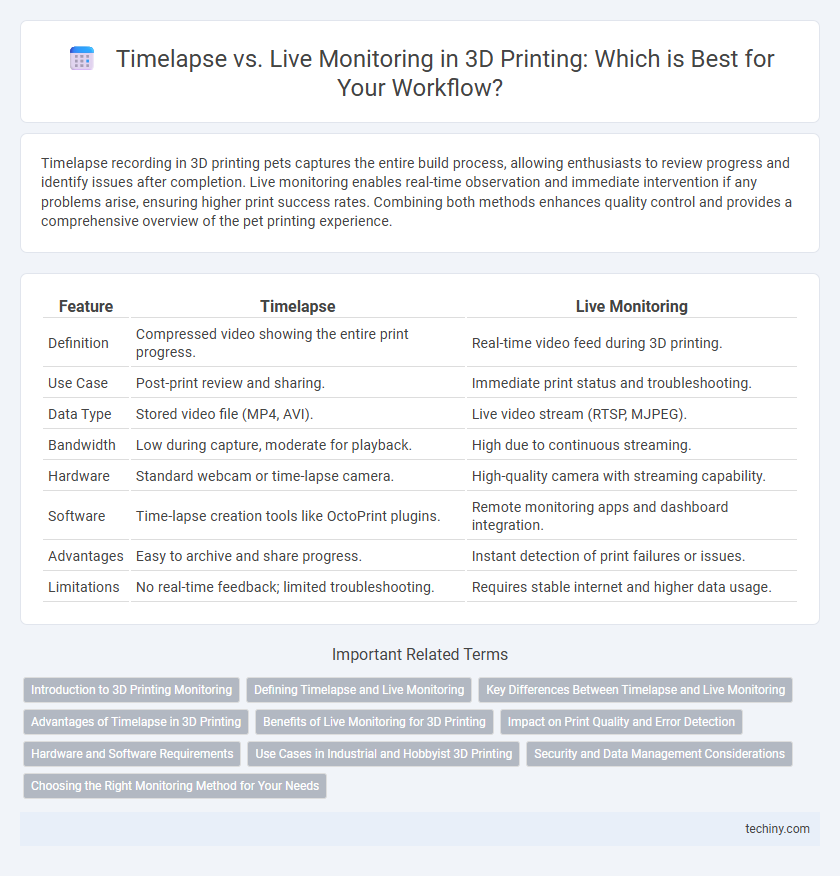Timelapse recording in 3D printing pets captures the entire build process, allowing enthusiasts to review progress and identify issues after completion. Live monitoring enables real-time observation and immediate intervention if any problems arise, ensuring higher print success rates. Combining both methods enhances quality control and provides a comprehensive overview of the pet printing experience.
Table of Comparison
| Feature | Timelapse | Live Monitoring |
|---|---|---|
| Definition | Compressed video showing the entire print progress. | Real-time video feed during 3D printing. |
| Use Case | Post-print review and sharing. | Immediate print status and troubleshooting. |
| Data Type | Stored video file (MP4, AVI). | Live video stream (RTSP, MJPEG). |
| Bandwidth | Low during capture, moderate for playback. | High due to continuous streaming. |
| Hardware | Standard webcam or time-lapse camera. | High-quality camera with streaming capability. |
| Software | Time-lapse creation tools like OctoPrint plugins. | Remote monitoring apps and dashboard integration. |
| Advantages | Easy to archive and share progress. | Instant detection of print failures or issues. |
| Limitations | No real-time feedback; limited troubleshooting. | Requires stable internet and higher data usage. |
Introduction to 3D Printing Monitoring
3D printing monitoring enhances print quality by providing real-time insights into the printing process through live monitoring, enabling immediate detection of errors and adjustments. Timelapse monitoring captures the entire print cycle in accelerated video format, useful for reviewing progress and diagnosing issues after completion. Choosing between timelapse and live monitoring depends on user needs for instant feedback or comprehensive post-print analysis.
Defining Timelapse and Live Monitoring
Timelapse in 3D printing captures the entire print process by taking periodic images, enabling users to review the print progression quickly after completion. Live monitoring provides real-time video feed and status updates, allowing immediate intervention during printing to address any issues. Both methods enhance print management but differ in immediacy and data granularity, with timelapse focusing on post-print analysis and live monitoring emphasizing ongoing oversight.
Key Differences Between Timelapse and Live Monitoring
Timelapse in 3D printing captures images at set intervals, producing a condensed video that highlights the entire print process, while live monitoring offers real-time streaming for immediate observation and intervention. Timelapse is ideal for post-print analysis, showcasing print progression and failures without constant attention, whereas live monitoring enhances print reliability through instant feedback and error detection. Key differences include timing of feedback, resource usage, and application focus--timelapse emphasizes historical review, while live monitoring prioritizes active print management.
Advantages of Timelapse in 3D Printing
Timelapse in 3D printing offers the advantage of compressing hours-long prints into short videos, enabling users to quickly review the entire printing process and identify defects or mechanical issues efficiently. This visual summary aids in improving print quality and troubleshooting by revealing layer inconsistencies and printer behavior over time. Unlike live monitoring, timelapse reduces the need for continuous oversight, freeing operators to manage multiple prints or tasks simultaneously without constant supervision.
Benefits of Live Monitoring for 3D Printing
Live monitoring in 3D printing enhances print quality control by providing real-time status updates and immediate detection of errors such as layer shifts or filament jams. This continuous observation reduces material waste and saves time by enabling prompt intervention to correct issues. Integration with smart devices and advanced camera systems allows users to oversee prints remotely, increasing convenience and operational efficiency.
Impact on Print Quality and Error Detection
Timelapse recording allows reviewing the entire 3D printing process post-completion, helping identify patterns affecting print quality but limits immediate error correction. Live monitoring provides real-time observation, enabling instant detection and intervention to prevent print failures and maintain print accuracy. Combining both methods enhances overall print quality assurance and reduces material waste by quickly addressing errors.
Hardware and Software Requirements
Timelapse 3D printing requires cameras with high-resolution sensors and software capable of capturing and processing sequential images efficiently to create smooth playback videos. Live monitoring demands hardware with robust connectivity, such as Wi-Fi or Ethernet modules, alongside real-time streaming software to provide immediate feedback and control during the printing process. Both systems benefit from compatible 3D printer firmware integration, with notable platforms including OctoPrint for live monitoring and various time-lapse video compilation tools tailored to 3D printing scenarios.
Use Cases in Industrial and Hobbyist 3D Printing
Timelapse recording captures the entire 3D printing process for post-production analysis, making it ideal for quality control and troubleshooting in industrial settings. Live monitoring provides real-time insights into print progress and immediate error detection, favored by hobbyists for on-the-fly adjustments and remote supervision. Industrial users prioritize timelapse for detailed documentation, while hobbyists benefit more from the accessibility and instant feedback of live monitoring.
Security and Data Management Considerations
Timelapse and live monitoring in 3D printing offer different security and data management advantages, with timelapse providing a compressed, archival record reducing storage demands while limiting real-time intervention. Live monitoring enables immediate detection of print errors or security breaches through constant data streaming, necessitating robust encryption and network protections to safeguard sensitive design files. Efficient data management strategies must balance the archival benefits of timelapse with the responsive, high-bandwidth requirements of live monitoring to optimize security and resource use.
Choosing the Right Monitoring Method for Your Needs
Timelapse monitoring captures periodic snapshots of a 3D print, providing a compressed overview ideal for reviewing the entire print process quickly and identifying major issues. Live monitoring offers real-time observation and immediate intervention, essential for complex prints requiring constant supervision and rapid troubleshooting. Selecting the right method depends on the printer's complexity, print duration, and user's need for instant feedback or post-process analysis.
Timelapse vs Live Monitoring Infographic

 techiny.com
techiny.com